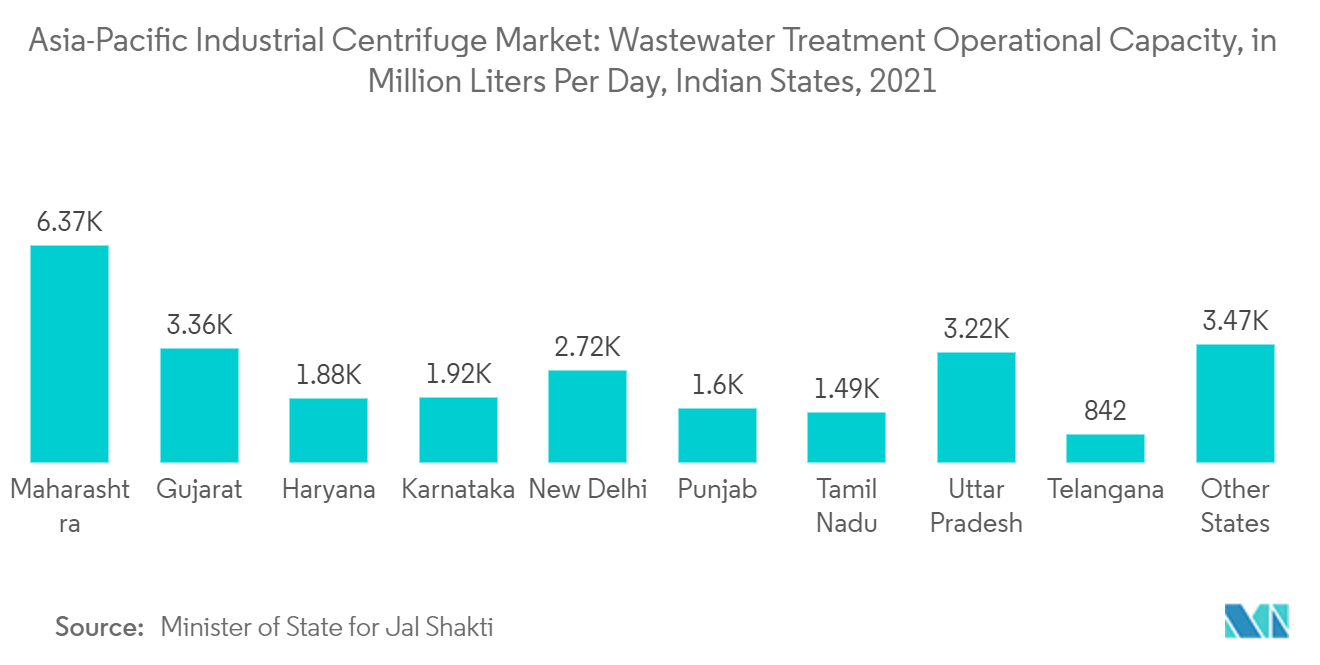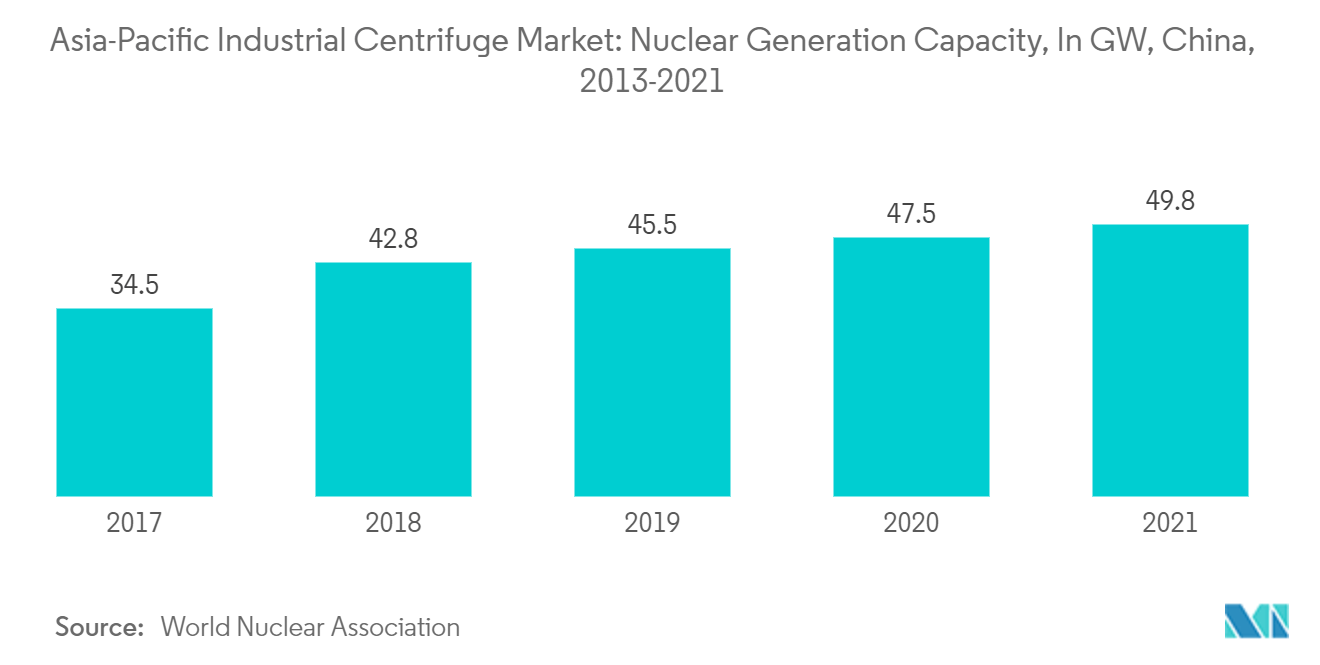Market Trends of Asia-Pacific Industrial Centrifuge Industry
Water and Wastewater Treatment Expected to be the Fastest Growing Market Segment
- Water and wastewater treatment technologies include a set of processes and equipment to remove contaminants from sewage and wastewater received from various industries, commercial buildings, and others by converting them into effluents that can be released into the environment with a reduced harmful impact. Centrifuges have a widespread application in treating wastewater produced by the automotive industry (soluble oils), agri-food industries, and steel mills. The application also extends to separating sludge-laden suspensions with high oil content.
- A major application of industrial centrifuges is sludge dewatering in wastewater treatment plants. Centrifugal thickening and dewatering is a high-speed process that uses the force from the rapid rotation of a cylindrical bowl to separate wastewater solids from liquid through filtration. Thickening before digestion or dewatering reduces the tankage needed for digestion and storage by removing water. Dewatering offers many advantages, such as reducing volume, saving money on storage and transportation, and eliminating free liquids before landfill disposal.
- Moreover, according to the Central Pollution Control Board's 2021 statistics, India's current water treatment capacity is 27.3% and its sewage treatment capacity is 18.6%. India's growing demand for wastewater treatment and zero discharge systems is expected to create significant opportunities for Indian companies offering wastewater technology and solutions. This is expected to propel the demand for industrial centrifuges for the water and wastewater treatment industries during the forecast period.
- The government of India announced various initiatives, such as the Jal Jeevan Mission, the National Mission for Clean Ganga, the Atal Mission for Rejuvenation and Urban Transformation, and Community Drinking Water Schemes, which are significantly contributing to the growth of the water and wastewater treatment industries in India.
- According to the Minister of State for Jal Shakti, Maharashtra state in India was projected to have the highest operational capacity for waste water treatment by 2021, with 6,336 million liters per day.
- As per the Minister of State for Jal Shakti statistics for 2021, under the Atal Mission for Rejuvenation and Urban Transformation (AMRUT) program of the Ministry of Housing and Urban Affairs, 883 sewerage and sewerage management projects amounting to INR 34,081 crore have been initiated, of which 370 projects costing INR 8,258 crore have been completed as of December 2021. Under the Swachh Bharat Mission (Urban) 2.0, launched in October 2021, INR 15,883 crore has been allocated to states and union territories (UTs) for wastewater management, including the establishment of sewage treatment plants (STPs) and fecal sludge treatment plants (FSTPs).
- Also, in June 2022, Daiki Axis Japan, a company that makes water treatment systems, said it would spend INR 200 crore to build its second sewage treatment plant in India. This plant would be in Palwal, Haryana. The plant is expected to have the capacity to produce 1,000 sewage treatment units with Japanese Johkasou technology and to commence operations by September 2023. The project is expected to drive demand for industrial centrifuges.
- Due to the above, it seems likely that the water and wastewater treatment segment will be the fastest-growing market for industrial centrifuges in the Asia-Pacific region during the forecast period.

China Expected to Dominate the Market
- China has the world's second-largest economy and is a leader in many fields, such as power, pharmaceuticals, chemicals, manufacturing, food, and drinks. Because of these things, China has a big share of the market for industrial centrifuges around the world.
- China has been an essential factor in the growth of the manufacturing sector worldwide. The country is the leader in the steel, chemical, power, and cement industries and is one of the top players in the petrochemical and refining industries. Despite the outbreak of COVID-19, the industrial sector in the country has registered growth of over 3% since April 2020, having reached an all-time high of 35.1% in January 2021. As per the National Bureau of Statistics of China, in 2021, China's industrial production increased by 9.6% compared to the previous year.
- China is the world's largest power consumer and the first-largest electricity generator worldwide. China had a total electricity consumption of about 8,310 terawatt hours in 2021. The consumption witnessed a notable increase compared to the previous year, when consumption amounted to approximately 7,510 terawatt hours. The rising demand from the power industry and its handling and processing infrastructure is expected to create significant demand for industrial centrifuges in the country.
- China is a major producer of nuclear power around the world. In 2021, China was projected to produce almost 14.4% of the world's nuclear power. The country's nuclear reactors produced 383.2 TWh of electricity in 2021. China was projected to account for about 5% of the share of nuclear power in total domestic electricity generation in 2021. China uses the most advanced technology and most stringent standards for the development of nuclear power plants and strictly manages the entire life cycle of nuclear power plants, from design, construction, and operation to decommissioning. As of December 2021, China had around 52 nuclear power reactors in operation with a combined capacity of 49.77 GW. As of 2020, the country generated around 366.2 TWh of electricity from nuclear power, representing 4.7% of the total electricity generation in the country.
- China has also put a lot of money into its refining and petrochemical infrastructure to meet domestic demand and make it easier for domestic industries to use petrochemicals. Plastics and other petrochemicals are being used more and more in industries like food packaging, clothing, cosmetics, and fertilizers. This means that refining capacity must be increased to keep up with the rising demand.
- China has been constructing new refineries and upgrading and adding capacity to older refineries. As of October 2021, nearly 1.8 million BPD of new refining capacity was under construction in China, with most expected to come online by the end of 2022. Additionally, expansion and upgrade operations are ongoing at multiple Chinese refineries. According to the Energy Information Administration (EIA), China was expected to become the world's largest oil refiner by the end of 2022, surpassing the United States.
- Since refineries and petrochemical businesses are growing and new nuclear power plants are going to be built, the country is likely to need more industrial centrifuges over the next few years.


